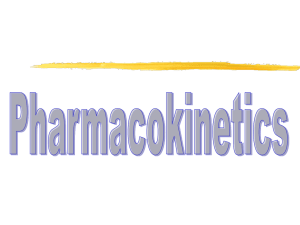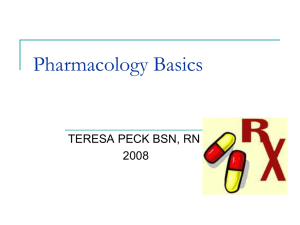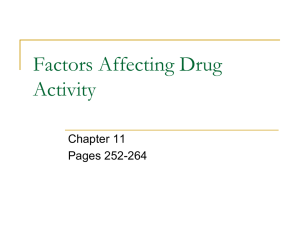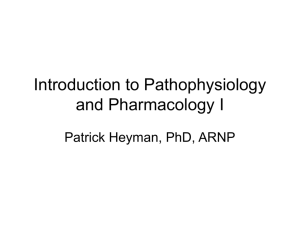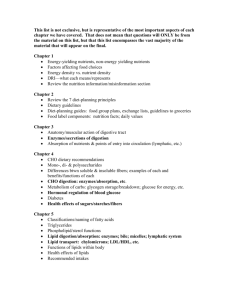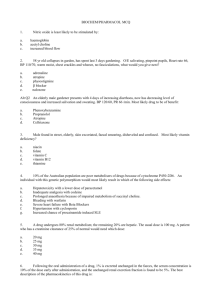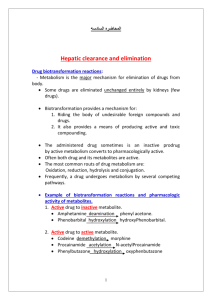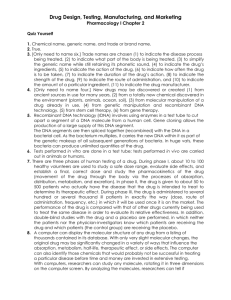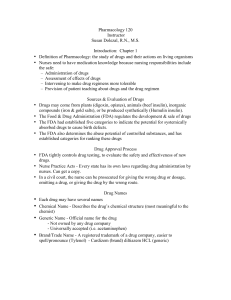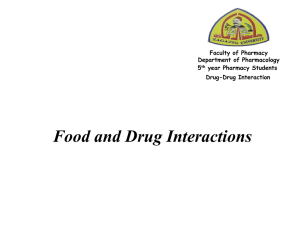Drug Action Across the Lifespan
advertisement
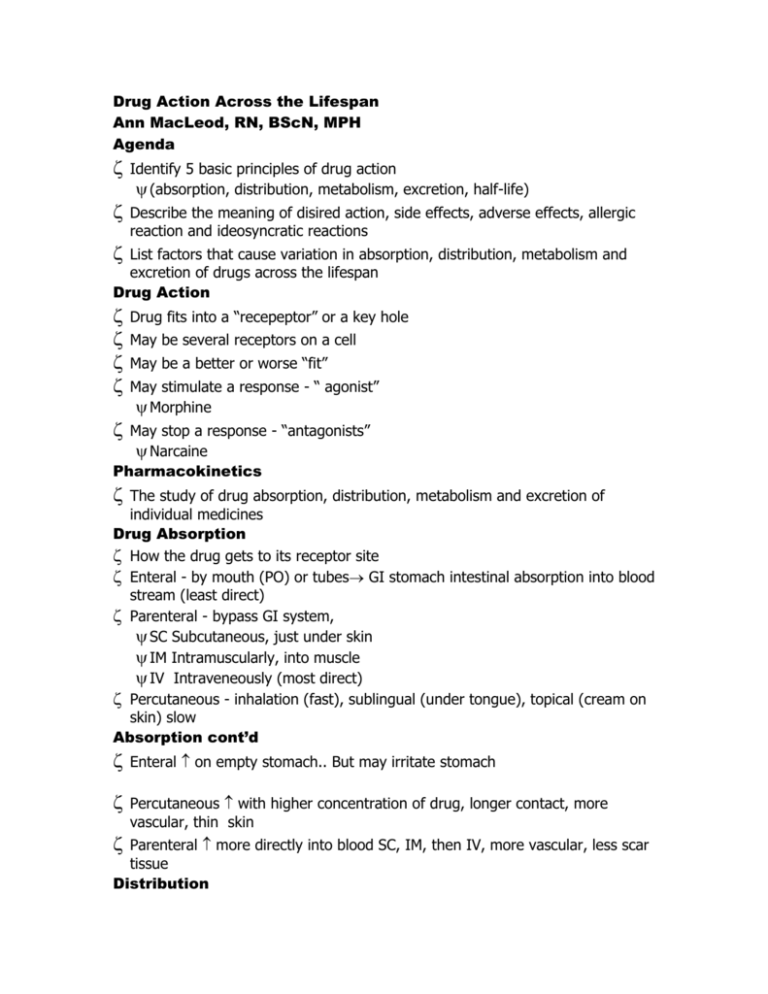
Drug Action Across the Lifespan Ann MacLeod, RN, BScN, MPH Agenda Identify 5 basic principles of drug action (absorption, distribution, metabolism, excretion, half-life) Describe the meaning of disired action, side effects, adverse effects, allergic reaction and ideosyncratic reactions List factors that cause variation in absorption, distribution, metabolism and excretion of drugs across the lifespan Drug Action Drug fits into a “recepeptor” or a key hole May be several receptors on a cell May be a better or worse “fit” May stimulate a response - “ agonist” Morphine May stop a response - “antagonists” Narcaine Pharmacokinetics The study of drug absorption, distribution, metabolism and excretion of individual medicines Drug Absorption How the drug gets to its receptor site Enteral - by mouth (PO) or tubes GI stomach intestinal absorption into blood stream (least direct) Parenteral - bypass GI system, SC Subcutaneous, just under skin IM Intramuscularly, into muscle IV Intraveneously (most direct) Percutaneous - inhalation (fast), sublingual (under tongue), topical (cream on skin) slow Absorption cont’d Enteral on empty stomach.. But may irritate stomach Percutaneous with higher concentration of drug, longer contact, more vascular, thin skin Parenteral more directly into blood SC, IM, then IV, more vascular, less scar tissue Distribution The way the drugs are transported to the receptors Lipid soluble drugs, sometimes bind and stored in adipose tissue “biotransformation” how the liver or other enzymes inactivate and “digest” the drug if attached to large proteins, lower concentration of “free” unattached molecules to get to the receptor sites May not cross blood- brain barrier or placenta Metabolism Preparation for excretion Excretion How the body rids itself of the metabolized or “digested” drug kidneys evaporation exhalation secretion into saliva or mother’s milk Half- Life The ammount of time required for half of the drug to be eliminated from the body e.g. half life of 100 mg is 12 hrs, 50 mg is left 12 hours. Divide the dose by 2 ( 25 mg) and Add half life time (12) to that time (12)… 24 hours Longer the half life digoxin, the less frequent the drug needs to be given Drug Actions Desired action - what you hope for Sever side effects - toxicity Side or adverse effects - in addition to the desired action may have another result - drowsiness Idio syncratic response - unexpected response Allergic reactions -- immune responses Allergic vs Analphylactic Urticaria - (hives) Rashes Edema - (local swelling) second reaction may be more serious Severe urticaria Edema around throat and face Bronchoconstriction and difficulty breathing ( dyspnea ) tachycardia( high heart rate ) hypotension ( low blood pressure) Variables affecting drug action Body weight mg/kg, larger more drug required Metabolic rate higher the metabolic rate the faster drug works and metabolizes Illness such as renal or liver disease impair metabolism may have build up of drug Psychological aspects placebo effect, works just because you think so Variables affecting drug action cont’d Tolerance : liver ‘learns’ how to metabolise the drug more efficiently therefore more of the drug is needed to reach therapeutic effects - morphine Dependence: physical or psychological so that if drug is discontinued withdrawl effects happen - usually the opposite of drug action - sedatives discontinued agitated , tremors Other drugs affecting drug action - Drug interactions Additive effect: sum of two drugs’ effects Synergistic: augmented effect Antagonistic: counteract each other Displacement: one drug displaces the other at the receptor site Interference: inhibits excretion or metabolism Drug absorption & Age age predictable topical absorption difficulty swallowing pills lower pH (more acidic) due to ulcer’s etc. Newborns and premies high pH may not have all the absorptive enzymes Drug Distribution and Age age less percentage of water lower concentrations of drug needed greater fat % fat soluble drugs longer time to act, prolonged action greater doses cirrhosis, liver failure little protein to bind smaller mg/kg ofprotein binding drugs Newborns and premies more water, higher concentrations per pound less %fat smaller mg/kg of fat soluble drugs little protein to bind smaller mg/kg ofprotein binding drugs Drug Metabolism and Age age improperly functioning enzyme pathways due to disease slower metabolism, lower doses Premies and newborns immature enzymes slower metabolism, lower doses frequent therapeutic drug blood levels to adjust dose Drug Excretion and Age age potential kidney disease detected by a raised creatinine level mean a lower dose/kg needs to be prescribed because the drug is not being excreted Premies and newborns immature kidneys mean a lower dose/kg needs to be prescribed because the drug is not being excreted Carcinogen vs Teratogen Mutates cell and can become cancerous A drug that can induce birth defects
